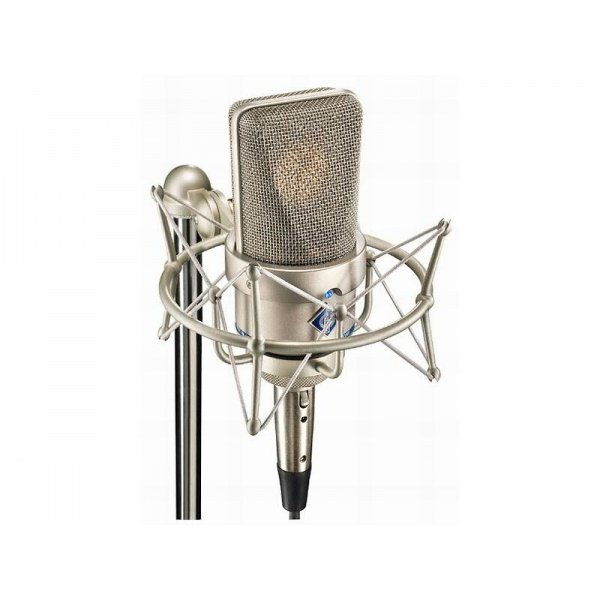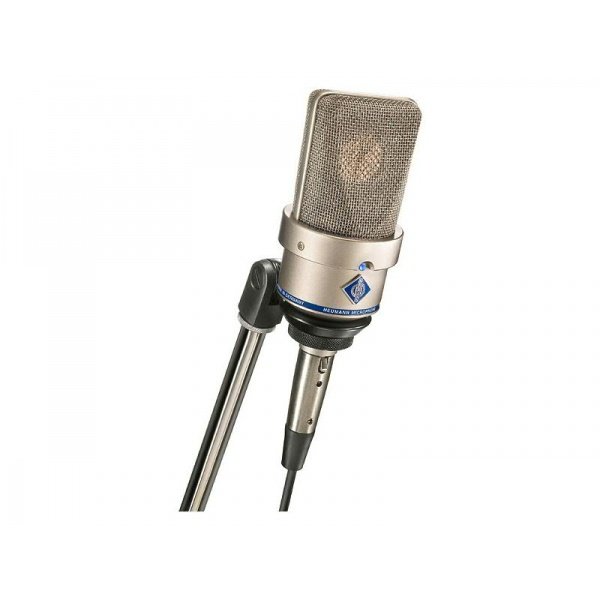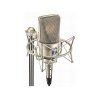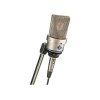Neumann TLM 103 D


Associate products for: Neumann TLM 103 D
Product Information
Pure Neumann sound in the digital domain, for use with AES/EBU,
AES 42 or S/PDIF. The signal is converted directly at the capsule. Difficult questions concerning the optimal preamp and A/D converter for a Neumann mic are thus a thing of the past.
Solution-D: A Microphone Technology Milestone
Neumann has repeatedly set new standards in the field of analog microphone technology. The first condenser microphone, switchable directional characteristics, the first stereo microphone and 48 V phantom power were all developed by Neumann, introducing new dimensions to the field of microphone and recording technology.
With the digital Solution-D microphone system, Neumann has now succeeded in bringing the dynamic range and signal fidelity of the best analog studio microphones into the digital realm. This means that, for the first time, the whole audio production signal chain is entirely digital.
Optimal A/D conversion, especially developed synchronization technology and the capability of controlling standard microphone parameters and various integrated signal processing functions remotely ensure that Solution-D meets the most demanding professional audio production requirements. The basic technological principle is to permit recording with no “bottlenecks” associated with loss of signal quality.
The comprehensive features provided by Solution-D make it possible to achieve excellent quality with small digital productions – with only a single microphone and a recording device.
The Solution-D digital microphone system is comprised of the following components: A digital microphone (available at the moment are the D-01 and TLM 103 D large-diaphragm microphones and the KM D small-diaphragm microphone), the DMI-2 digital microphone interface and the RCS remote control software, which operates and remotely controls the microphone. A PC or Mac can serve as the control computer, which of course can simultaneously be used to operate the actual recording system, for instance.
The signal and data transmission of the microphone conform to the new AES 42 standard. The introduction of this standard governing the transmission of output signals, the supply of power and the remote control of microphones with digital outputs provided the necessary preconditions for the development of digital microphone technology. Neumann made a decisive contribution to the drafting of the AES 42 standard.
Instead of being used with the DMI-2, the KM D small-diaphragm microphones and the TLM 103 D large-diaphragm microphone can alternatively be connected to the AES/EBU or S/PDIF interface of a recording system by means of a Connection Kit. However, if a Connection Kit is used, it is not possible to control the microphone functions remotely. Thus a control computer is not required. In this case, if it is necessary to synchronize several microphones, a sample rate converter must be used.
Any audio engineer who is familiar with digital technology can begin production with Solution-D immediately, without extensive training. The additional features provided by digital microphones open up new possibilities for production.
Remote control of standard microphone parameters
With the DMI-2 digital microphone interface, familiar microphone settings such as the directional characteristic, pre-attenuation and low-cut filter can be controlled remotely. Changing the settings of microphone parameters is greatly simplified, which facilitates rapid testing of different settings so as to optimize the sound quality. It is no longer necessary to make handwritten records of all of the settings.
Integrated digital audio signal processing
An A/D converter developed by Neumann, especially optimized for the capsule signal conditions, receives the output signal directly from the microphone capsule. Level matching required for subsequent devices is performed digitally, in the microphone itself. Analog components such as preamplifiers and A/D converters are thus no longer required, resulting in significant cost savings.
The immediate conversion of the analog signal results in a significant improvement in the dynamic range. This is perceptible throughout the entire signal chain, making level adjustments less critical.
Mixing console functions such as mute and phase reverse, which affect the microphone signal, are likewise integrated into the microphone. For the D-01, even commands such as “On Air” (red light) are executed by means of remotely controlled microphone LEDs. A particularly significant feature is the transient limiter function. For the first time, this function can be applied at the most effective point, at the signal source, in order to reduce harmful transients. In the case of analog microphones, in the subsequent signal path a great deal of headroom must be provided for such signals, which are very short but which have a large amplitude.
Data transmitted by the microphone
Information transmitted by the microphone includes the name of the manufacturer, the model, the serial number, the software version installed in the microphone, and a list of remotely controlled functions supported by the microphone. Status indicators such as certain warning functions and operating readiness are also transmitted.
During production, the audio engineer can continuously monitor the status of the microphones, since all the important parameters, including signal levels, are displayed on the screen. In addition, a text input field is provided, allowing a channel name to be assigned, e.g. indicating the sound source. All of the microphone settings can be stored in configuration files and retrieved as required.
Why digital signal processing?
The digitization of audio data began many years ago, at the end of the signal processing chain, with the development of the first digital recording equipment. Almost all audio signal processing components are now available in digital form.
It is well-known that digital signals provide the necessary preconditions for mathematically precise calculations and processing, permitting signals to be modified, copied, transmitted and stored as desired, with no loss of quality.
In contrast, analog signal processing is characterized by limited precision, error accumulation, a lack of redundant signal information, and the use of error correction procedures. Each analog signal processing step is thus associated with a degradation of signal quality.
This results in a gradual decrease in the dynamic range, due to the introduction of noise voltages and nonlinear distortion.
In addition, digital processing permits the performance of functions that are difficult or impossible to execute via analog signal processing. This applies particularly to functions that are based on intermediate data storage.
A/D conversion
Despite continuing improvements, integrated circuits available on the market still constitute a limiting factor in the conversion of audio data from analog to digital form.
For instance, the best delta-sigma A/D converters currently available as integrated circuits provide a dynamic range of 115 dB to 120 dB (A-weighted), for a theoretical word length of 24 bits.
This can be compared with the dynamic range of up to 130 dB exhibited by a high-quality analog condenser microphone. In order to prevent the addition of noise to the signal, a significantly improved A/D converter is therefore required. The conversion process must simultaneously be optimized for the signal levels and source impedance found in the microphone.
When A/D conversion is carried out in a mixing console or other equipment, as a rule, loss of signal quality is to be expected, since the conversion occurs after level matching has already been performed. As a result, the dynamic range is affected by headroom considerations and by the characteristics of the microphone preamplifier and the A/D converter.
The development goal was thus to effect high-quality digitization of the capsule signal directly in the microphone, so as to permit level matching and other processing steps to be performed digitally. This is the only way of preserving the signal quality that is generated by the microphone.+
Synchronization
The AES 42 standard describes two modes of synchronizing the microphone with the receiver (e.g. a mixing console or DMI-2 digital microphone interface):
Mode 1: The microphone operates asynchronously, using the sampling rate of its internal quartz oscillator. In this case, a sample rate converter is required at the receiver. However, this mode of operation should be used only if mode 2 synchronization is not possible, since conventional sample rate converters will impair the signal quality, for instance in terms of dynamic range and latency time.
Mode 2: The microphone is synchronized with a master word clock, which can be either an external word clock or the internal word clock of the DMI-2. In this case, a frequency/phase comparison of the microphone signal with the master word clock is carried out in the AES 42 receiver (DMI-2). A control signal is then generated that is transmitted via the remote control data stream to the microphone, where it controls the frequency of the internal quartz oscillator.
Via the BNC output of the DMI-2, the internal word clock generator can be used to synchronize additional DMI-2s and subsequent processing equipment, such as a mixing console.
TLM 103 D digital large-diaphragm microphone
The TLM 103 D, available immediately, is the digital version of a classic mic for home recording and project studios.
In the microphone, the Neumann A/D converter which has been extensively proven in the D-01 receives the output signal directly from the capsule. With a dynamic range exceeding that of the capsule, the converter permits optimal utilization of the capsule qualities. This ensures that the capsule signal is made available to the recording system without any coloration, with a hitherto unknown transparency.
If required, the DSP functions integrated into the microphone can be configured and controlled remotely via the DMI-2 digital microphone interface and the RCS remote control software. These functions include gain setting, a compressor/limter with an additional de-esser function, and a peak limiter. The digital concept proves particularly beneficial here. The peak limiter, which receives the output signal almost directly from the capsule, acts as an automatic “safety valve”, permitting safe exploitation of the entire available dynamic range even in stressful recording situations.
For the purpose of clear identification, information concerning the name of the manufacturer, model, serial number and installed software version is transmitted by the microphones to the connected receiver.
The microphones are equipped with a 3-pin XLR connector for transmission of a bi-directional signal conforming to the AES 42 standard. This signal includes the balanced digital microphone output signal, the phantom power supply, and a remote control data stream that also contains a signal for synchronizing the microphone with a master clock.
Two versions of the TLM 103 D are available: Classic nickel, and black finish. All standard sampling frequencies are supported, from 44.1 kHz to 192 kHz.
S/PDIF and AES/EBU Connection Kits
In addition to the DMI-2 digital microphone interface, Neumann is now offering attractively priced Connection Kits to permit easy connection of individual miniature microphones or a TLM 103 to the widely used S/PDIF and AES/EBU interfaces. This makes it possible for numerous users to enjoy “Neumann sound direct to disk”, without the extensive functionality of the comprehensive DMI-2. An upgrade to the DMI-2, with its configuration capabilities and DSP functions, is of course possible at any time. A plug-in power supply is included as a standard feature.
Attractive Starter Sets for an economical entry into the field of digital microphone technology
Starter Sets offer a straightforward introduction to digital microphone technology at a very attractive price. They include a KM 184 D or TLM 103 D microphone and a Connection Kit for either an S/PDIF or AES/EBU connection. An interesting aspect for those budgeting for future purchases of recording equipment is that an A/D converter is already integrated into the digital Neumann system, and that a preamplifier is not required. Another advantage is the elimination of compatibility considerations. All of the components are available from a single source, so that the Neumann microphone sound can be captured on a digital recording medium with no coloration.
The DMI-2 digital microphone interface
Equipment that supports the new AES 42 standard can process the output signals of Solution-D microphones directly. In all other cases, the DMI-2 digital microphone interface is used. The DMI-2 is a separate, two-channel device which converts the AES 42 data format supplied by the microphone into an AES/EBU signal.
The DMI-2 is operated via the Neumann RCS remote control software, which is installed on a desktop or laptop computer. The computer is connected to the DMI-2 via a USB port and a USB to RS 485 interface converter. If a large number of microphones is used, several DMI-2s can be cascaded. In this case, each digital microphone interface can be addressed individually.
In addition to a word clock input and output, the DMI-2 also has an internal word clock generator. If no master word clock signal (e.g. from a mixing console) is present at the input, the DMI-2 internal word clock is used automatically to synchronize the two microphone channels, and the signal is switched to the word clock output.
External commands such as “On Air” (red light) can be controlled via a 9-pin user port.
RCS remote control software
The digital microphones can be controlled via the RCS remote control software, which is a component of the Solution-D system. The software runs as an independent program on a desktop or laptop computer.
All important parameters are displayed on the screen and can be changed at any time. During production, the audio engineer can monitor the operating status and parameters of all connected microphones, and can change the settings quickly and easily if necessary.
The parameters displayed include the directional characteristic, pre-attenuation, low-cut filter, gain, various microphone status indicators, command indicators, and mute and phase reverse functions. It is also possible to monitor signal levels on the screen.
Information transmitted by the microphone, such as the name of the manufacturer, model and serial number, is displayed for clear identification of the microphone. In addition, it is possible to input additional information, such as the name of the sound source. Settings for the complete microphone setup can of course be stored and retrieved as required.
Features
▪ TRUE NEUMANN SOUND: The legendary Neumann sound in the digital realm.
▪ Pure Neumann capsule sound.
▪ TRUE TO THE ORIGINAL: The satisfaction of recording the uncolored original, with no "bottlenecks" between the capsule and the recording system.
▪ TRUE CONVERSION: The guarantee of having one of the best A/D converters available.
▪ TRUE HANDLING SAFETY: Anti-clipping processing ensures handling safety, and reduces stress
▪ TRUE TIME SAVINGS: Reduced time requirements and personnel costs, particularly due to faster post production processing
▪ TRUE ECONOMY: Lower investment costs, since separate A/D converters and preamps are no longer needed. This also means space and weight savings (e.g. in the OB van)
- Shop
- Pro audio
- Microphone
- Neumann TLM 103 D


